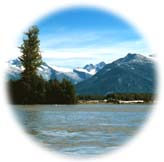
The value of the Tourism Zonation System (TZS) approach to tourism land use planning is that it identifies areas that are environmentally and ecologically suitable for different types of tourism development based on the naturalness (level of disturbance) of the existing land base. Tourism products can then be developed that conform with existing land uses and infrastructure, rather than changing the underlying land use patterns. This is especially critical with tourism planning in and around protected areas, where conservation is the primary management objective.

Where tourism development changes fundamental land use patterns, the impacts are generally more detrimental than when the development is consistent with existing land use. As landscapes are developed, there are fewer and fewer Backcountry and Midcountry areas with increasing Frontcountry and Urban areas. For example, a new "wilderness" lodge within a previously undeveloped wilderness may displace some wilderness-oriented activities with Midcountry tourism activities.
Then, if a primitive road is put into improve access to the lodge, the area becomes Midcountry, with more mechanized forms of recreation (e.g. off-roading, snow-mobiling, car camping), further displacing non-mechanized recreation (wilderness trekking). Eventually, if the road is upgraded and paved to provide recreational vehicle access, the area becomes Frontcountry.
The trend towards loss of wilderness is increasing rapidly worldwide and is generally irreversible. With the normal pattern of development, wilderness and Backcountry recreation and tourism opportunities become increasingly scarce, while Urban and Frontcountry areas and associated uses become increasingly common. From the perspective of wilderness conservation, almost all development involves the 'downgrading' of lesser developed areas (Backcountry and Midcountry zones), into Frontcountry  and Urban zones through increased ease and frequency of access. and Urban zones through increased ease and frequency of access.
Such access development is often the front edge of the wedge, eroding wilderness wherever roads, planes, boats and helicopters gain increasingly easy access. For example, locating a new multi-day heli-hiking operation in a wilderness area can result in adverse impacts to backpack, wilderness trail ride, and nature safari operators (existing and potential), as well being likely to disturb wildlife populations.
Ironically, such a site would also likely be too remote to provide adequate visitor flow to the heli operator. By contrast, locating such an operation in the Midcountry would afford the operator better accessibility to clientele and would avoid the potential for the various wilderness environmental impacts. In effect, by locating such a tourism operation in the appropriate zone enhances both its economic and environmental attributes. Another way of expressing this tourism zonation design principle, is "Match the activity to the zone, not the zone to the activity".
|
BACKCOUNTRY AND MIDCOUNTRY ZONES ARE THE HIGHEST PRIORITY FOR CONSERVATION
What this means for parks management is that a systematic process should be undertaken to identify tourism zones and manage them accordingly. Given that the Park Service's primary objective is to conserve the natural values of the park system, the Backcountry zone is the priority for conservation since it is the zone with the most intact ecosystems and biodiversity. In large part, this means keeping facilities and road access out of pristine Backcountry areas. The Midcountry zone serves as a  buffer to Backcountry parks, cushioning them from Frontcountry tourism and other industrial uses (in accordance with Conservation Biology principles). Ideally Midcountry operations should be located outside and adjacent to the parks. Such a strategy will benefit the conservation and management of parks, and the economic needs of operators. buffer to Backcountry parks, cushioning them from Frontcountry tourism and other industrial uses (in accordance with Conservation Biology principles). Ideally Midcountry operations should be located outside and adjacent to the parks. Such a strategy will benefit the conservation and management of parks, and the economic needs of operators.
Larger, resort-type operations (e.g. ski hills, golf courses, cross-country ski resorts) should be situated in the Frontcountry outside of parks where ease of access and higher tourism volumes, higher site carrying capacities, and lower overall environmental sensitivity occur. By contrast, facilities in wilderness locations should be at most non-permanent tent camps. In southern areas of BC, where wilderness locations are comparatively small, and where comparatively high Backcountry demand can be anticipated, built facilities should not be constructed at all within wilderness zones.
Rather, permanent facilities should be situated on the Midcountry periphery of wilderness areas with guests venturing out into the Backcountry from  modest, unobtrusive facilities. With this approach, the wilderness environment (upon which the operator relies) is maintained and more people can be accommodated within the wilderness, using non-motorized travel and without causing irreparable damage than would be the case if a facility attracted and focused intensive use within the Backcountry. modest, unobtrusive facilities. With this approach, the wilderness environment (upon which the operator relies) is maintained and more people can be accommodated within the wilderness, using non-motorized travel and without causing irreparable damage than would be the case if a facility attracted and focused intensive use within the Backcountry.
Midcountry locations are ideal for establishing small to mid-sized lodges. Here a sense of intimacy with nature prevails, but access is easy enough to enable moderate numbers of tourists to reach destinations and therefore justify construction costs. Located outside on the rim of parks, developments in the Midcountry must be carefully designed to avoid degrading adjacent wilderness values.
The Tourism Zonation System is an essential tool for planning conservation-based tourism development. Tools for identifying land base capability to support tourism products is described in more detail in the following section.
|

